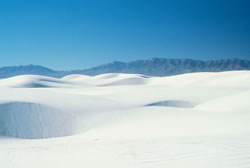White Sands of New Mexico:
White Sands National Monument preserves a major portion of this unique dune field, along with the plants and animals that have successfully adapted to this constantly changing environment.
White Sands Institute
Have you ever wanted to take a photography workshop led by a professional photographer in New Mexico’s most visited national park area? Or learn about the unique animal and plant species of New Mexico’s White Sands?Field seminars combining a mixture of outdoor field excursions along with classroom presentations. Will be taught by renown experts. Information about other classes for the 2010 season will be posted later in fall of 2009.
The White Sands Institute field seminars combine a mixture of outdoor field excursions along with classroom presentations. All courses will take place at White Sands National Monument. The field seminars will be taught in small groups, so interested individuals are advised to register as soon as possible before classes fill up. To register for classes or for more information, contact New Mexico State University – Alamogordo’s Office of Community Services at 575-439-3842. The class schedule for 2010 will be posted in early 2010. Please check back at that time.
 Did You Know?
Did You Know?Only a handful of gypsum dune fields exist and the white sands dune field is by far the world's largest, covering 275 square miles.
 |
| Gypsum dunes |
 | Did You Know? Because there is virtually no fresh water within the white sands dune field, animals that live in the dunes must get almost all their water solely from the food they eat. Desert animals have evolved many ways of conserving moisture. The kangaroo rat eats only dry seeds and never drinks water. | |||
 | Did You Know? Unlike most other birds, which have three front toes and one back toe, the roadrunner has two front and two back toes, allowing it to run down its prey. Look for its distinct X-shaped tracks on the white sands. |
 | Did You Know? Three species of lizards, one pocket mouse and numerous species of insects have evolved a white coloration for survival in the white sands. |






No comments:
Post a Comment